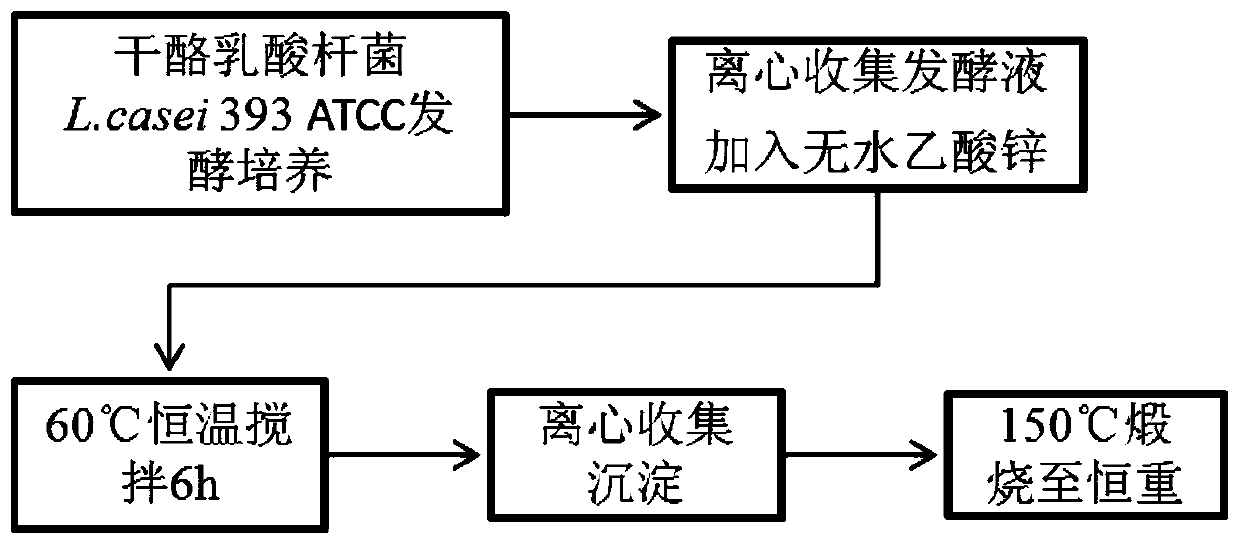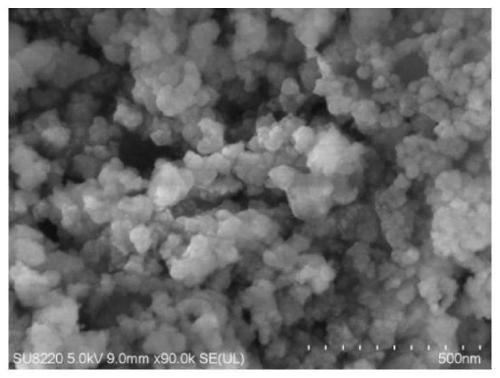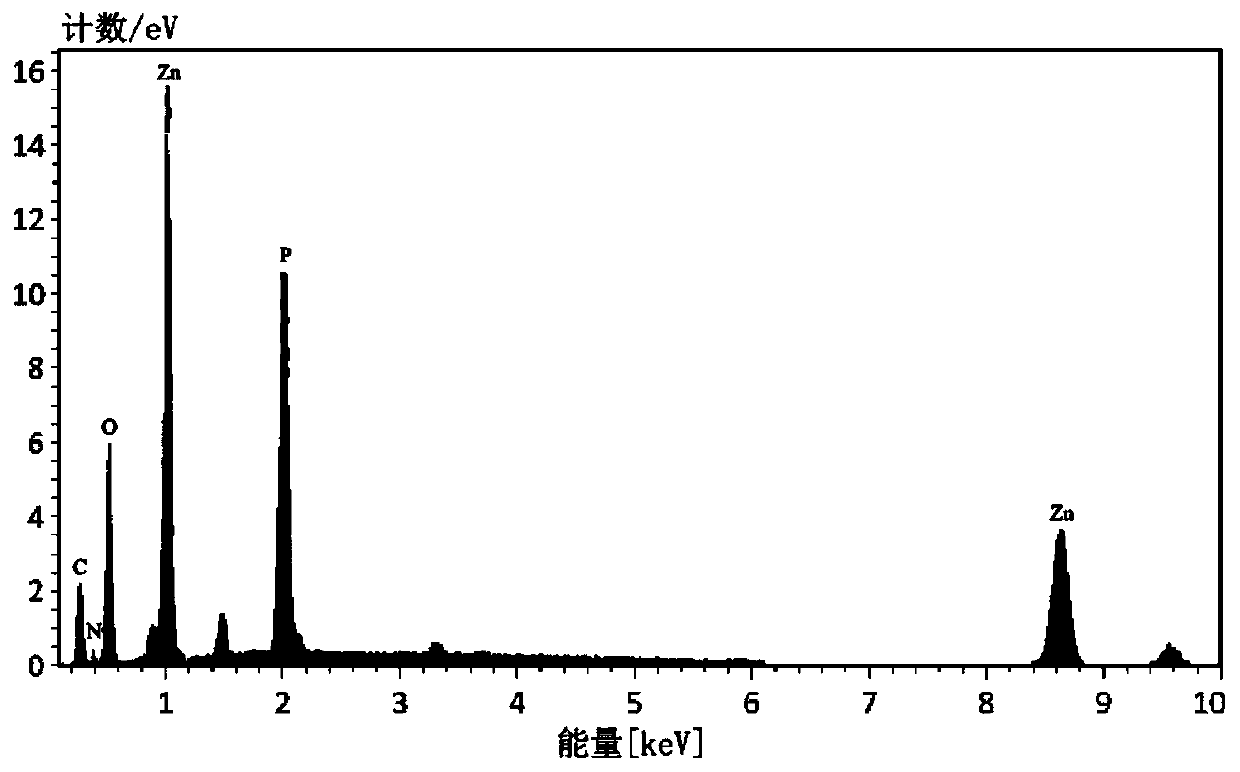Method for preparing nanometer zinc oxide based on Lactobacillus casei secretion
A technology of Lactobacillus casei and nano-zinc oxide, which is applied in the field of preparing nano-zinc oxide, can solve the problems of low purity of nano-zinc oxide, and achieve the effects of low toxicity, high yield and high purity
- Summary
- Abstract
- Description
- Claims
- Application Information
AI Technical Summary
Problems solved by technology
Method used
Image
Examples
Embodiment 1
[0018] Step 1. Strain activation:
[0019] Lactobacillus casei L.casei ATCC 393 strain was activated and cultured with MRS solid medium. The formula of MRS solid medium was as follows: peptone 10g / L, beef extract 10g / L, yeast extract 5g / L, diammonium hydrogen citrate 2g / L L, glucose 20g / L, crystalline sodium acetate 5g / L, dipotassium hydrogen phosphate 2g / L, magnesium sulfate heptahydrate 0.6g / L, manganese sulfate monohydrate 0.25g / L, Tween 801mL / L, agar 15g / L , pH 6.4; L.casei ATCC 393 was inoculated in MRS solid medium by streaking, and cultured anaerobically at 37°C for 48h.
[0020] Step 2, biosynthesis of zinc hydroxide:
[0021] Cultivate the single colony of Lactobacillus casei L.casei ATCC 393 picked with MRS liquid medium. The formula of MRS liquid medium is as follows: peptone 10g / L, beef extract 10g / L, yeast extract 5g / L, dihydrogen citrate Ammonium 2g / L, glucose 20g / L, crystalline sodium acetate 5g / L, dipotassium hydrogen phosphate 2g / L, magnesium sulfate heptahy...
Embodiment 2
[0032] Step 1. Strain activation:
[0033] Lactobacillus casei L.casei ATCC 393 strain was activated and cultured with MRS solid medium. The formula of MRS solid medium was as follows: peptone 11g / L, beef extract 11g / L, yeast extract 4g / L, diammonium hydrogen citrate 1.5g / L, glucose 23g / L, crystalline sodium acetate 4g / L, dipotassium hydrogen phosphate 2.3g / L, magnesium sulfate heptahydrate 0.5g / L, manganese sulfate monohydrate 0.27g / L, Tween 80 1.3mL / L, Agar 18g / L, pH 6.2; Streak inoculation of L.casei ATCC 393 on MRS solid medium, culture anaerobically at 35°C for 36h;
[0034] Step 2, biosynthesis of zinc hydroxide:
[0035] Cultivate the single colony of Lactobacillus casei L.casei ATCC 393 picked with MRS liquid medium, the formula of MRS liquid medium is as follows: peptone 11g / L, beef extract 11g / L, yeast extract 4g / L, dihydrogen citrate Ammonium 1.5g / L, glucose 23g / L, crystalline sodium acetate 4g / L, dipotassium hydrogen phosphate 2.3g / L, magnesium sulfate heptahydr...
Embodiment 3
[0039] Step 1. Strain activation:
[0040] Use MRS solid medium to activate Lactobacillus casei L.casei ATCC 393 strain. The formula of MRS solid medium is as follows: peptone 12g / L, beef extract 12g / L, yeast extract 6g / L, diammonium hydrogen citrate 2.5g / L, glucose 25g / L, crystalline sodium acetate 6g / L, dipotassium hydrogen phosphate 2.5g / L, magnesium sulfate heptahydrate 0.5g / L, manganese sulfate monohydrate 0.3g / L, Tween 80 1.5mL / L, Agar 20g / L, pH 6.6; Streak inoculation of L.casei ATCC 393 on MRS solid medium, culture anaerobically at 38°C for 42h;
[0041] Step 2, biosynthesis of zinc hydroxide:
[0042] Cultivate the single colony of Lactobacillus casei L.casei ATCC 393 picked with MRS liquid medium, the formula of MRS liquid medium is as follows: peptone 12g / L, beef extract 12g / L, yeast extract 6g / L, dihydrogen citrate Ammonium 2.5g / L, glucose 25g / L, crystalline sodium acetate 6g / L, dipotassium hydrogen phosphate 2.5g / L, magnesium sulfate heptahydrate 0.6g / L, manganes...
PUM
| Property | Measurement | Unit |
|---|---|---|
| particle size | aaaaa | aaaaa |
Abstract
Description
Claims
Application Information
 Login to View More
Login to View More - R&D
- Intellectual Property
- Life Sciences
- Materials
- Tech Scout
- Unparalleled Data Quality
- Higher Quality Content
- 60% Fewer Hallucinations
Browse by: Latest US Patents, China's latest patents, Technical Efficacy Thesaurus, Application Domain, Technology Topic, Popular Technical Reports.
© 2025 PatSnap. All rights reserved.Legal|Privacy policy|Modern Slavery Act Transparency Statement|Sitemap|About US| Contact US: help@patsnap.com



